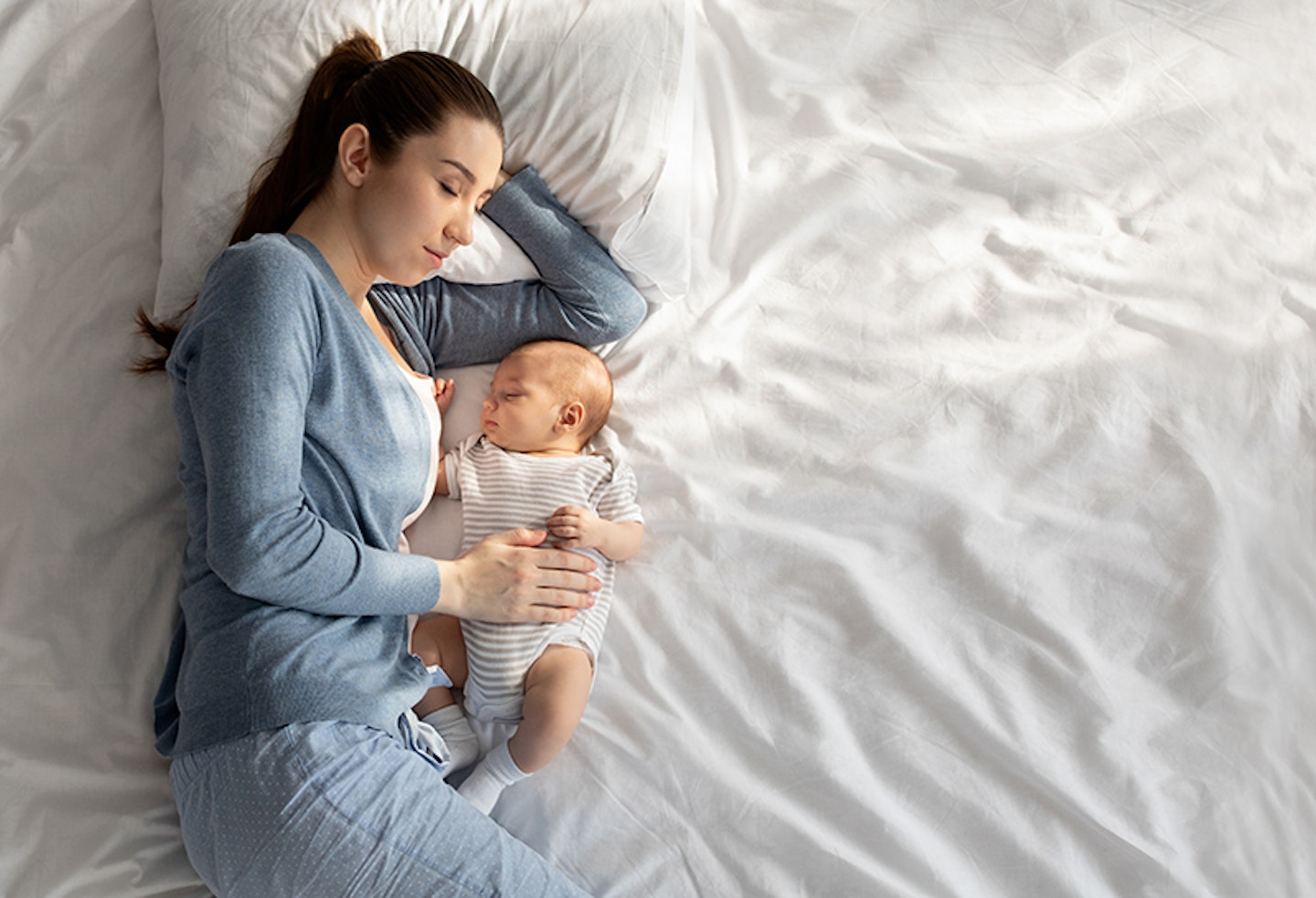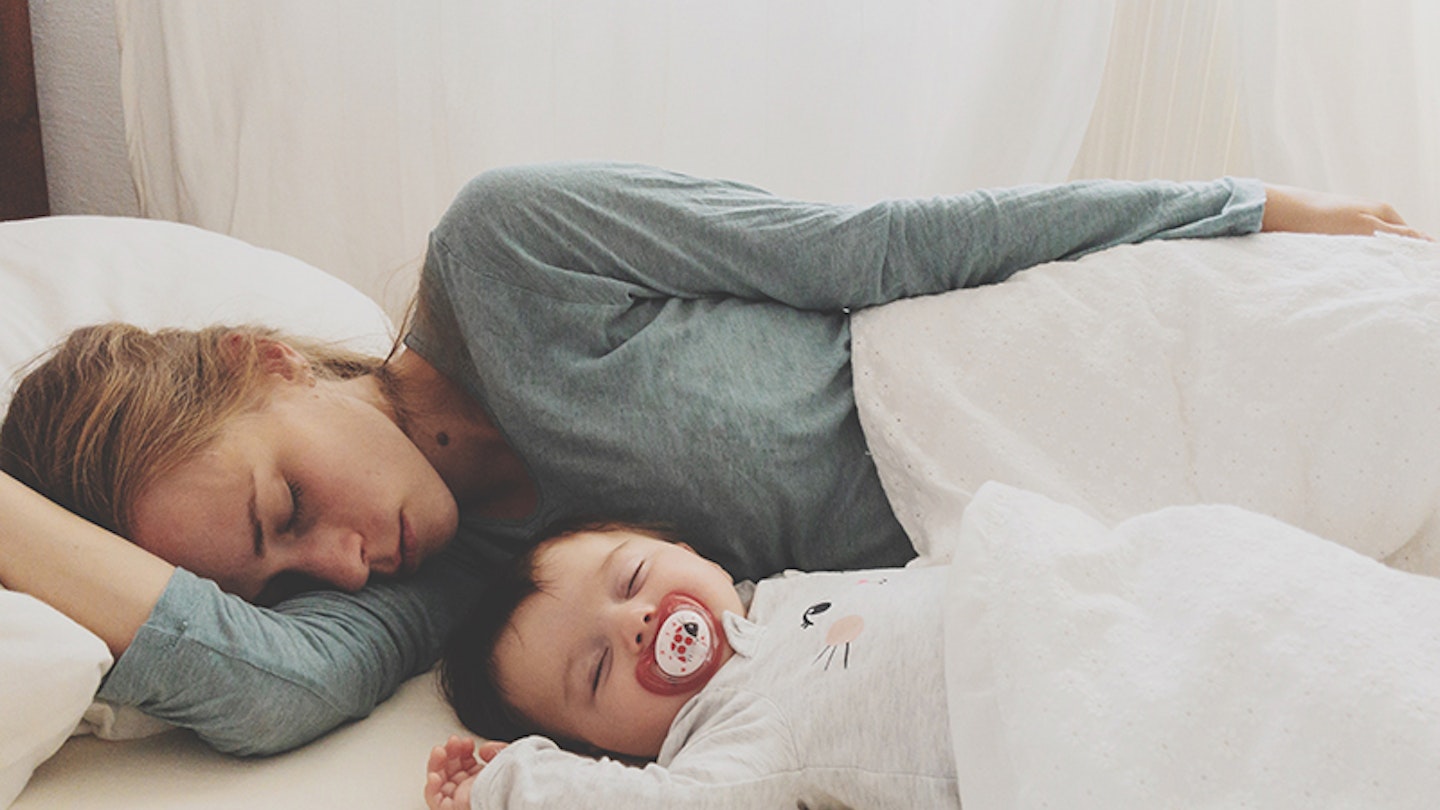Making sure your baby sleep's through the night is very important; some parents will opt for a cot bed or crib, others a Moses basket, but some parents choose to share their bed space with their baby, known as ‘co-sleeping’.
“There are lots of reasons why co-sleeping happens,” says Jenny Ward, CEO of the Lullaby Trust. “Some parents want to co-sleep from the beginning because that choice feels right for them. Other parents end up having their baby in bed with them because they find their baby settles better that way, or because they’re so tired they accidentally doze off.”
Is co-sleeping safe for newborns?
The expert guidelines are clear: for the first six months of your baby’s life, the safest place for him to sleep is in a cot, bedside crib or a Moses basket or cot in the same room as you. But of the (roughly) 700,000 babies born each year in England and Wales, half will have slept in their parents’ bed – with either one or both of their parents – by the time they’re three months old.
Co-sleeping is a very personal choice. There are benefits to sharing a bed with your baby; the closeness and security can help babies to sleep better and it can be very helpful if you’re breastfeeding. But there are also potential hazards, such as the adult bedding accidentally covering the baby. “The thing parents worry about with young babies and sleep is sudden infant death syndrome, or SIDS,” says Jenny.

In 2016, 219 babies died of SIDS in the UK: 0.03 of all births. It’s estimated that half were in cots or Moses baskets and half were co-sleeping. “But of those co-sleeping babies, 90% were described as sleeping in a largely preventable, hazardous situation,” says Jenny. “In other words, they weren’t co-sleeping safely.
“It’s important to remember that SIDS is rare. In the UK it’s gone down by 79 per cent since 1991, which is the year when the Back To Sleep campaign began. That campaign encouraged parents to put babies to sleep lying on their backs, which is the safest position for young babies to sleep in.”
How to safely co-sleep
If you do choose to co-sleep with your baby, Jenny advises getting things prepared in advance. “Start by taking a look at your surroundings. You need to think about who will be sleeping in the bed; the best place for you all to be positioned and the bedding that you’ll need.”
Who's in the bed?
While it’s fine for both you and your partner to sleep in the bed with your baby, it’s important that no pets are in the bed and that the only child is the baby. "If extra children or animals are in the bed, it increases the risk of your baby being rolled on or having his face accidentally covered by bedding or a furry tail," says Jenny.
If that rule is going to be tricky for you – perhaps you have a toddler who sees your bed as his territory – you may find that it’s safer to have your baby in his own cot, rather than in the bed.
Where in the bed?
"The key things to remember is that you want your baby to be in a position where he’s not at risk of falling off the bed and he’s not at risk of getting trapped between the mattress and the wall," says Jenny. "He also needs to be positioned well away from your pillow."
A common sleeping arrangement is to have mum in the centre of the bed, with baby on one side of her at a slight angle and dad on the other. "You need to find a way of sleeping that works for your family", says Jenny, "but you may find that you instinctively adopt a protective pose, curled on your side, facing your baby, with one arm stretched out above him."
You also need to think about what you will do as your baby approaches the age at which he has more mobility. Babies may start to roll as early as four months. It’s likely that your baby’s first ‘roll’ will be an unexpected flip from his tummy onto his back, when you’re giving him tummy time. It takes more strength to roll from his back onto his tummy – but some babies will do this early. "Once this mobility kicks in, there is a greater risk of babies moving into hazardous positions in the bed," says Jenny. "Make sure you’re aware of this and plan for it before your baby reaches this milestone!"
Tip: You don’t want your baby to get hot, so when you’re thinking about how to position your baby in bed, keep him away from radiators or from windows that catch the sun in the early morning.
The bedding
With your bed you’re aiming for a clear, uncluttered surface – the same as your baby would have in a crib, a bed extension or a baby box. "Babies need to sleep on firm, flat surfaces,’ says Jenny. ‘You don’t want your baby in a nest or a pod – he should just be on the mattress, with a waterproof mattress cover and a sheet underneath him."
Don’t put him on top of a duvet – it’s too puffy a surface for a baby to lie on. It can also trap too much heat underneath him. "The easiest thing to do is to dress your baby in an age-and-temperature appropriate bodysuit and sleep bag and lie him on the mattress, well away from any bedding or pillows," says Jenny.
That’s your baby sorted. But what about you? "The reason it’s vital to keep all adult bedding – pillows, duvets, blankets – away from your baby is because they could obstruct his breathing or cause him to overheat," says Jenny. "But that does mean that you have to be creative about what you snuggle up in." This is easier in the summer when you can wear pyjamas and layer up with a duvet over your feet and lower legs – tucked in below where your baby is lying.
In the winter you can curl up in a sleeping bag, or layer up with thermals, fleece jammies and bed socks. Don’t turn up the heating to compensate though – the right temperature range for baby sleep is 16-20ºC. And never bring a hot water bottle into a bed with a baby. "If you find you’re not comfortable enough to nod off, then put your baby back into his cot," says Jenny. "Your sleep is important, too!"
When not to co-sleep

Jenny says there are some babies who should never co-sleep, these are:
• Babies who were premature
• Babies who weighed under 5½ lbs when they were born
• Babies with a parent who smokes or with a parent who smoked during pregnancy
• Babies with a parent who drunk alcohol or taken drugs (including medications that make you drowsy)
"It’s also vital that you only co-sleep with your baby in a bed," says Jenny. "Never co-sleep in a sofa or an armchair. Sleeping on a sofa with a baby increases the chances of SIDS by up to 50 times." It’s not fully understood why sleeping in sofas and armchairs poses such a risk to babies, but it’s probably linked to the greater risk of youngsters getting into positions in which their breathing is obstructed.
"Having a young baby is exhausting and of course, parents get tired," says Jenny. "But if there is any possibility that you might fall asleep, put your baby down in his cot before you get to that stage of sleepiness." That need to sleep may be particularly intense at night. If it is, prepare your bed for safe co-sleeping and opt to feed your baby in bed, rather than sitting in an armchair or sofa. That way, if your eyelids start to droop, you can put your baby down in a safe position next to you before you nod off.
Thousands of parents co-sleep in the UK. If you want more information about how to do it safely, chat to your health visitor or call The Lullaby Trust’s free information line on 0808 802 6869.
Meet the Expert: Jenny Ward, mum-of-two, is the CEO of the Lullaby Trust, which raises awareness of sudden infant death syndrome (SIDS) and provides expert advice on safer sleep for babies.
